|
 Secure Site
Secure Site
|
 |
Archive for the 'Well-being' Category
 yoga can help you relax and sleep Put away your pills and roll out your yoga mat. These yoga poses help relieve insomnia.
When was the last time you had a good night’s rest? According to the National Sleep Foundation, sleep deprivation is on the rise: As many as 71 percent of Americans get far less than the recommended eight hours.
There are two primary categories of sleeplessness, says Judith Hanson Lasater, Ph.D., P.T., author of Relax and Renew: Restful Yoga for Stressful Times. One is physiological (too much coffee or alcohol, hormonal changes, illness, jet lag); the other is psychological (stress, worry, unresolved conflict).
“You may hold your thoughts at bay all day long,” explains Lasater, “but when you sleep, they’re still spinning in your mind.”Yoga helps slow the spin, she says, adding, “It’s not that you go to sleep and then relax—it’s that you get relaxed and then go to sleep.”
Poses that support you completely with props are the key to creating a relaxed body and mind. “When you feel supported, the only response is relaxation,” Lasater notes. This sleep-enhancing set includes Side-Lying Corpse Pose, which teaches “total release, total softening,” she says: “It’s the ultimate form of letting go.The focus is directed inward to shift you from doing to being.”
Do these 3 poses one after the other. If you wake up sleepless in the middle of the night, leave your bed and do any of the 3 you choose.
Supported Reclining Pose
- Place a pillow on your mat,along with a folded blanket to support your head. Roll 3 additional blankets.
- Sit in front of the pillow with your tailbone at its edge. Bend your knees and place a blanket roll underneath.
- Lean back and rest your torso on the pillow and your head on the folded blanket. Let your heels rest on the mat. Place each forearm on a rolled-up blanket, both palms turned up.
- Take several long,deep breaths. As you exhale,allow your belly to drop into your pelvis. Feel the tension melt away. Stay here for at least 15 minutes.
Simple Supported Backbend
- Stack 2 blankets, one folded around the other,and place them horizontally on the mat.
- Sit on the mat with your back to the blankets, your knees bent, and your feet flat. Lean back and place your elbows on the blankets for support and balance.
- Slowly roll backward until your lower back is completely supported by the blankets and your head is on the mat. Bring your arms out to your sides, palms turned up. Close your eyes.
- Breathe slowly and evenly, allowing your body to soften. Stay here for 1 minute, then gradually increase your time in the pose.
Side-Lying Corpse Pose (Caution: If you are more than 3 months pregnant, lie on your left side only.)
- Sit on your mat with your props—2 folded blankets and 2 king-sized pillows—nearby. Lean on one arm, then lower yourself to the mat so you’re lying on your side with your knees bent.
- Place one blanket under your head and the other between your knees, shins, and ankles.
- Place one pillow lengthwise in front of you and the other behind you so you’re lying between them; hug the front pillow as you relax into both. Close your eyes and take several slow, easy breaths. Relax your jaw and eyes. Stay here for 20 minutes.
Use our unique “Zen Clock” which functions as a Yoga Timer. It features a long-resonating acoustic chime that brings your meditation or yoga session to a gradual close, preserving the environment of stillness while also acting as an effective time signal. Our Yoga Timer & Clock can be programmed to chime at the end of the meditation or yoga session or periodically throughout the session as a kind of sonic yantra. The beauty and functionality of the Zen Clock/Timer makes it a meditation tool that can actually help you “make time” for meditation in your life. Bring yourself back to balance.
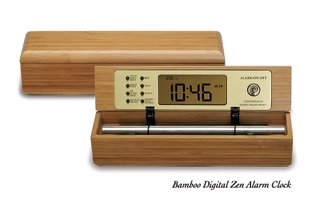 Chime Yoga Timers and Alarm Clock
adapted from Natural Health Magazine, by Nora Isaacs
 Natural Wake Up Clock with Chime Now & Zen – The Yoga Timer Store
1638 Pearl Street
Boulder, CO 80302
(800) 779-6383
Posted in sleep, Sleep Habits, Well-being, yoga, Yoga Timer, Yoga Timers by Now & Zen
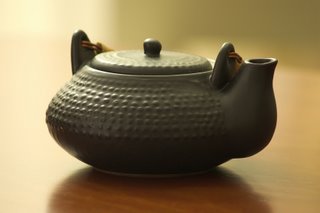 tea solutions What it is
A member of the mint family, lemon balm has a distinct lemony flavor and aroma, which makes it a popular garden herb. Although it’s mild enough to use for treating children’s ailments, lemon balm is a powerful herbal healer for adults as well.
Why it’s used
Herbalists today primarily use lemon balm for easing insomnia, anxiety, stress, and digestive upsets. It is also used to ward off insects and heal bug bites. The recent discovery of the herb’s antiviral compounds has made it popular as a topical treatment for oral and genital herpes.
History and folk remedies
Lemon balm has been cultivated for more than 2,000 years as a medicinal plant. As early as the tenth century, Arab physicians recommended the flavorful herb for easing nervous tension. In medieval Europe, extracts of lemon balm became a fashionable sedative; the emperor Charlemagne decreed that the herb be grown in every monastery garden in his domain. Throughout the Middle Ages, herbalists prescribed lemon balm for insomnia, headaches, nervous stomach, anxiety, depression, and menstrual cramps. From the time of ancient Greece, lemon balm was also used to help heal minor wounds and to treat bug bites and stings.
How it works
Researchers have identified a variety of compounds in lemon balm with mildly sedative properties that relax the nervous system. Other compounds, including fragrant essential oils, help to relieve indigestion. The plant contains polyphenols, compounds that fight infection-causing bacteria; this supports the traditional use of lemon balm for healing wounds. Laboratory studies also show that lemon balm has antiviral properties. Scientists theorize that the herb prevents viruses from attaching to cells.
Scientific support
In a German study, lemon balm combined with valerian (Valeriana officinalis) was found to significantly improve sleep quality when compared with a placebo (Fitoterapia, 1999, vol. 70, no. 3). Another study showed that the same herbal formula was as effective as the pharmaceutical tranquilizer Halcion but without the negative side effects typical of sedative drugs (Therapiewoche, 1992, vol. 42).
 lemon balm The botanical name Melissa comes from the Greek word for bee, because bees love this flowering herb. German researchers have also proven the effectiveness of lemon balm as a herpes treatment. In a recent study, 116 people with herpes sores (oral and genital) were given either a cream containing 1 percent lemon balm extract or a placebo. Those using the herb had a significantly better recovery rate than those using the placebo (Phytomedicine, 1994, vol. 1, no. 1). Another study followed 66 individuals just starting to develop a cold sore. On day two, those using the lemon balm cream were healing more quickly, had less discomfort, and exhibited fewer and smaller blisters than those not taking the herb (Phytomedicine, 1999, vol. 6, no. 4).
Dose
To make a lemon balm tea, pour 1 cup of boiling water over 2 teaspoons of dried leaf (or 2 tablespoons of fresh leaves). Set your Zen Timer with Chime for 15 minutes. Cover, steep for 15 minutes, strain, and drink. For insomnia, drink 1 cup 30 minutes before bed. For stress and anxiety, drink up to 3 cups throughout the day. If you prefer using a concentrated liquid extract, take 1/2 to 1 teaspoon diluted in a small amount of warm water up to three times a day.
adapted from Delicious Living, July 2004 by Laurel Vukovic
“The Zen Alarm Clock & Chime Timer’, uses soothing acoustic chimes that signal it’s time – gently and gradually.
Rather than an artificial recorded sound played through a speaker, the Zen Clock features an alloy chime bar similar to a wind chime. When the clock’s alarm is triggered, its chime produces a long-resonating, beautiful acoustic tone reminiscent of a temple gong.
 Digital Zen Timer with Chime, a good timer for lemon balm tea Now & Zen’s Chime Timer Store
1638 Pearl Street
Boulder, CO 80302
(800) 779-6383
Posted in Bamboo Chime Clocks, sleep, Sleep Habits, Well-being, Zen Timers
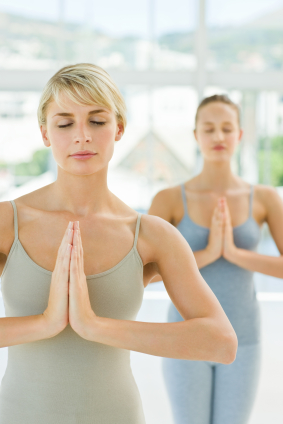 yoga to recharge Flick on your energy switch and get centered with this ancient 10-minute yoga routine.
In the high peaks of the Himalayas, there are spiritual seekers known to have extraordinary endurance and youthfulness, not to mention that ever-elusive inner peace. Their secret? A centuries-old series of daily yogalike postures known as the Five Tibetan Rites of Rejuvenation. “The monks found this routine to be a key to their age-defying vitality and inner fulfillment,” says Carolinda Witt, a teacher of the rites and author of The 10-Minute Rejuvenation Plan (Three Rivers Press, 2005). Thanks to Witt, who has adapted the rites for those who can’t travel to the Himalayas, you can experience the power of these five exercises in your own home. The moves target the chakras—the spinning energy centers that extend from the base of your spine to the crown of your head—and get them to spin rapidly, and in unison. “The rites rev up your chakras to their fullest potential,” says Witt. “It’s like turning on an inner power switch.” Besides a boost in energy, flexibility, and core strength, Witt’s students report handling stress better, feeling more focused, having a stronger sense of purpose, and experiencing an overall feeling of connectedness.
THE FIRST RITE
SpinningIncreases energy flow; improves balance and coordination; enhances circulation.
EMOTIONAL BENEFITS: Creates a sense of joyfulness and freedom.
A. Stand with your feet hip-width apart and your arms straight out to your sides at shoulder height, palms facing down. Relax your shoulders and gaze forward. Begin spinning in place, clockwise.
PHYSICAL BENEFITS:
B. Pivot on your right heel (but keep your right foot pressed into the floor—you’ll be sliding your toes in a clockwise circle) and step your left foot next to your right foot. Move at a speed that’s comfortable, and breathe normally through your nose. Avoid taking short, choppy steps with your left foot-the goal is to spin as smoothly as possible. Keep count of every turn by softly focusing on a stationary object, like a door or piece of furniture, and noting each time you pass it.
TO FINISH: When you’ve completed all your repetitions (for your first week, do three), stop and place your hands on your hips for balance. Close your eyes and take three deep, cleansing breaths.
TO PROGRESS: Turn on both feet instead of anchoring yourself with your right foot, and increase your speed.
THE SECOND RITE
Modified Leg Raise Strengthens the core, hips, lower back, legs, and neck.
EMOTIONAL BENEFITS: Promotes mental clarity and inner confidence.
PHYSICAL BENEFITS:
A. Lie on your back on a yoga mat with a folded towel under your lower back. Keep your legs together and straight and place your hands behind your head, fingers interlaced. Contract your abdominals and press your pelvis toward the mat; keep your abs tight throughout this exercise. Inhale and lift your head and shoulders off the floor slightly. Hold your breath as you bend your right knee and bring it directly over your right hip, keeping your lower leg parallel to the floor.
B. Straighten your right leg and flex your foot, pointing it toward the ceiling.
TO FINISH: Exhale and bend your right knee until your lower leg is again parallel to the floor. Then bring your right foot to the mat and slide it down to meet your left foot as you lower your head and shoulders to the mat. Repeat the move with your left leg. When you’ve completed all your repetitions (for the first week, do three), take three deep, cleansing breaths.
TO PROGRESS: Instead of raising one leg at a time, raise both legs. And instead of bending at the knee, use your abs to lift your legs straight off the mat and bring your feet toward the ceiling, keeping your lower back in contact with the mat.
THE THIRD RITE
Kneeling Backbend
PHYSICAL BENEFITS: Opens the front of the body; relieves muscle tension; stretches the spine.
EMOTIONAL BENEFITS: Helps connect you to your emotions; gives you full access to your creativity; allows you to go with the flow.
A. Kneel on a yoga mat with your legs hip-width apart, your knees in line with your hips (contract your abdominals to keep your hips from pushing forward), your toes curled under, and your hands on your buttocks, fingers pointing down. Keep your back straight.
B. Keeping your abdominals contracted, inhale as you lift your chest (without puffing out your ribs). Arch your back slightly and look up, gently squeezing your shoulder blades together, keeping your neck long. (Rather than bending back, focus on lengthening up and opening your chest.)
TO FINISH: Exhale and return to start position. When you’ve completed all your repetitions (if this is your first week, do three), take three deep, cleansing breaths.
TO PROGRESS: Deepen the stretch in your back: Press your shoulder blades together more firmly while lengthening your spine up. Squeeze your buttocks to keep your hips aligned over your knees.
THE FOURTH RITE
Tabletop Builds strong arms, wrists, shoulders, and legs; improves balance and stability; invigorates the circulatory and lymphatic systems.
EMOTIONAL BENEFITS: Initiates feelings of stability, balance, and order; enhances self–discipline and improves productivity.
PHYSICAL BENEFITS:
A. Sit on a yoga mat with your legs about hip-width apart, your knees slightly bent, and your feet flat on the floor about two feet away from you. Place your hands behind you near your hips, palms flat on the mat and fingers pointing toward your toes. Pull your abdominals toward your spine.
B. Inhale as you press down through your hands and feet, and lift your hips off the floor until they’re at the same height as your knees. Slide your knees forward until they’re aligned over your ankles. Bring your head back slightly and gaze toward the ceiling, keeping your neck long. Your posture should look like a flat tabletop with your torso parallel to the floor, arms straight, wrists aligned with shoulders, and knees aligned with ankles.
TO FINISH: Exhale and lower to the starting position. When you’ve completed all your repetitions (if this is your first week, do three), take three deep, cleansing breaths.
TO PROGRESS: Start by sitting with your legs extended in front of you rather than bent; this will further strengthen and stretch the arms, wrists, and shoulders.
THE FIFTH RITE
Pendulum Relieves fatigue and stress; improves flexibility and overall strength.
EMOTIONAL BENEFITS: Promotes insight, passion, and expansion.
PHYSICAL BENEFITS:
A. Come onto your hands and knees on the yoga mat, with your hands under your shoulders (fingers pointing forward) and your knees under your hips. Keep your arms straight and move your hands forward three to five inches. Contract your abdominals and tuck your pelvis toward your spine. Curl your toes under. Inhale and lift your knees off the mat. Lift your tailbone toward the ceiling and straighten your legs as much as possible without locking your knees until your body forms an inverted V. Press your heels toward the floor. Keep your neck in line with your back and your head between your upper arms. Gaze toward the mat.
B. Exhale, contract your buttocks, come onto the balls of your feet, and lower your hips toward the mat while shifting your weight to your hands, keeping your arms straight. Slide your head forward and up, open your chest, and gaze up slightly. Press your shoulders back; your body should be parallel to but not touching the floor.
TO FINISH: Return to start position. When you’ve done all your repetitions (if this is your first week, do three), take three deep, cleansing breaths.
TO PROGRESS: Contract your abdominals throughout the entire move to further strengthen your core.
Use our unique “Zen Clock” which functions as a Yoga & MeditationTimer. It features a long-resonating acoustic chime that brings your meditation or yoga session to a gradual close, preserving the environment of stillness while also acting as an effective time signal. Our Yoga Timer & Clock can be programmed to chime at the end of the meditation or yoga session or periodically throughout the session as a kind of sonic yantra. The beauty and functionality of the Zen Clock/Timer makes it a meditation tool that can actually help you “make time” for meditation in your life. Bring yourself back to balance.
adapted from Natural Health Magazine, by Holy St. Lifer
 Tibetan Bowl Clock with brass bowl/gong , a perfect yoga timer with gentle gong Now & Zen – The Yoga and Meditation Timer Store
1638 Pearl Street
Boulder, CO 80302
(800) 779-6383
Posted in intention, Well-being, yoga, Yoga Timer, Yoga Timers by Now & Zen
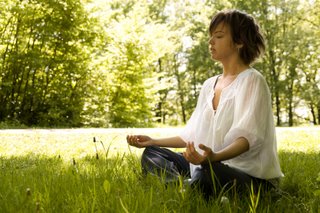 meditation guide With practice, this beginner meditation will hold the mind steady even during periods of stress.
A well-trained, stable, and focused mind is an asset in every sphere of life, and essential for any spiritual endeavor. The practice below will develop your concentration, clarity, and inner stability, by providing a single object as the resting place for your mind’s awareness—the universal mantra soham. Practice daily at about the same time, set your Meditation Timer by Now & Zen for 10 minutes, starting with 10 minutes, and gradually increasing to 20–30 minutes, or longer.
Step 1.
Begin by training your body to be still and comfortable in a sitting posture. When the spine is erect with the pelvis, chest, and head vertically aligned, the breath becomes smooth, and the mind alert and relaxed. Sit on a chair, or cross-legged on the floor with a cushion or a folded blanket under the hips. Use enough support to lift the hip joints slightly higher than the knees. This minimizes the effort needed to keep the lower back from rounding.
Step 2.
Close your eyes and mentally draw a circle of light around yourself. The circle separates you from the world of daily life—both the outer world of perceptions and activities, and the world of your familiar preoccupations and thinking patterns. With this intention, see yourself sitting inside this circle of light. It delineates a space in which you can contain your awareness; let it protect you from disturbances, distractions, and mental dissipation.
Step 3.
Feel the entire body sitting comfortably still, release any unnecessary tension, and pay attention to the movement of the breath. Refine your awareness as you feel the breath become smoother and more subtle, expanding from the solar plexus into the limbs on the inhalation, and releasing back to the solar plexus on the exhalation. Be aware of the touch of the breath everywhere in the body.
Step 4.
Making sure the body and breath stay relaxed, focus your attention at each of the following energy centers, moving systematically through the body and inhaling and exhaling once at each point: eyebrow center · throat center · right shoulder · right elbow · right wrist · each of the right fingertips, starting with the thumb · right wrist · right elbow · right shoulder · throat center · left shoulder · left elbow · left wrist · each of the left fingertips, starting with the thumb · left wrist · left elbow · left shoulder · throat center · heart center · navel center · center of the pelvis · pelvic floor · center of the pelvis · navel center · heart center · throat center · eyebrow center.
Step 5.
Now rest your attention at the eyebrow center. Feel the ebb and flow of the breath through the inner space of the whole body, while maintaining your focus on the eyebrow center. Sense the vibration of a slow wave of breath. This vibration is the mantra soham (pronounced so-hum). Hear the sound so on the inhale, and the sound ham on the exhale. The breath is subtle and slow, so let your concentration be fine and sensitive, becoming more and more one-pointed, and gradually drawing deeper into the mind. Rest in this awareness as long as you like.
To finish the practice, gradually return your awareness to the flow of the breath in the body, the physical presence of the body, and the space around you. Remain aware of the breath and your inner connection as you release the body from your sitting posture. You may want to open your eyes into the palms of your hands, massage your face, and stretch your arms and legs before getting up.
Use our unique “Zen Clock” which functions as a Yoga Timer. It features a long-resonating acoustic chime that brings your meditation or yoga session to a gradual close, preserving the environment of stillness while also acting as an effective time signal. Our Yoga Timer & Clock can be programmed to chime at the end of the meditation or yoga session or periodically throughout the session as a kind of sonic yantra. The beauty and functionality of the Zen Clock/Timer makes it a meditation tool that can actually help you “make time” for meditation in your life. Bring yourself back to balance.
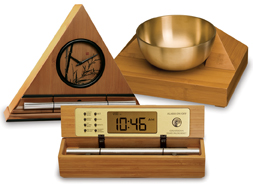 Meditation Timers with Singing Bowls & Chimes adapted from Yoga International Magazine, by Sandra Anderson
 Zen Alarm Clock, Ukiyo-e Hokusai Wave Dial Face, mediation timer and clock Now & Zen’s Meditation Timer Store
1638 Pearl Street
Boulder, CO 80302
(800) 779-6383
Posted in Chime Alarm Clocks, Meditation Timers, Meditation Tools, mindfulness practice, Now & Zen Alarm Clocks, Well-being, Zen Timepiece by Now & Zen, Zen Timers
 Feng Shui your bedroom for a better rest Use Feng Shui principles to set up your bed and you could wake up more rested.
Use Feng Shui principles to set up your bed and you could wake up more rested, according to Ellen Whitehurst, a feng shui consultant and author of the upcoming book Make This Your Lucky Day (Ballantine, 2007). The goal is to balance the energy in your bedroom so you can relax-to do this, start by placing the head of your bed against a wall, which will give you a feeling of stability (a headboard has the same effect). But don’t put your bed in a corner. “Leave space on both sides of your bed so energy can circle freely around you,” says Whitehurst. If possible, move your bed so you can see your door without being directly across from it-or in front of a window. This arrangement, called “the command position,” will subconsciously make you feel more secure by allowing you to see who is coming into your room without being startled.
Boulder, Colorado—an innovative company has taken one of life’s most unpleasant experiences (being startled awake by your alarm clock early Monday morning), and transformed it into something to actually look forward to. “The Zen Alarm Clock,” uses soothing acoustic chimes that awaken users gently and gradually, making waking up a real pleasure.
What makes this gentle awakening experience so exquisite is the sound of the natural acoustic chime, which has been tuned to produce the same tones as the tuning forks used by musical therapists. According to the product’s inventor, Steve McIntosh, “once you experience this way of being gradually awakened with beautiful acoustic tones, no other alarm clock will ever do.”
adapted from Natural Health Magazine
 Chime Alarm Clock, the original progression wake up clock with soothing Feng Shui Chime to awaken you gently Now & Zen – The Peaceful Alarm Clock Store
1638 Pearl Street
Boulder, CO 80302
(800) 779-6383
Posted in Feng Shui, sleep, Sleep Habits, Well-being
 meditation may increase compassion Meditation might be your prescription for a happier mind and kinder heart, a new University of Wisconsin-Madison study shows. Scientists worked with 16 Tibetan monks and 16 meditation novices, giving the beginners lessons on compassion meditation two weeks prior to a series of brain-scan experiments. Those brain scans — taken while the participants responded to different emotional cues — revealed that the monks had more activity in certain brain regions involved in processing empathy. The findings, according to study authors, suggest that meditation may train the brain to increase feelings of compassion and happiness.
To start your own meditation practice, try this exercise created by “Untrain Your Parrot” author Elizabeth Hamilton:
- Set your Zen Meditation Timer with Gong for 20 minutes.
- Sitting with your spine erect, breathe deeply, placing your fingertips over the center of your chest if you like.
- As you inhale, picture a person to whom you want to extend compassion. As you exhale, silently say, “May compassion awaken.” Inhale and exhale for several breaths, focusing on the center of your chest.
- Recalling the person, silently say, “May whatever clouds compassion be healed.” Repeat this cycle with the phrase, “May this moment be experienced, exactly as it is,” and finally, “May compassion be extended to all.”
- Repeat the exercise for 20 minutes until your Zen Timer Gongs.
Use our unique “Zen Clock” which functions as a Yoga & Meditation Timer. It features a long-resonating acoustic chime that brings your meditation or yoga session to a gradual close, preserving the environment of stillness while also acting as an effective time signal. Our Yoga Timer & Clock can be programmed to chime at the end of the meditation or yoga session or periodically throughout the session as a kind of sonic yantra. The beauty and functionality of the Zen Clock/Timer makes it a meditation tool that can actually help you “make time” for meditation in your life. Bring yourself back to balance.
adapted from Body + Soul Magazine, August 2007
 Zen Timepiece, a brass singing bowl clock and timer for meditation and yoga Now & Zen – The Zen Timer Store
1638 Pearl Street
Boulder, CO 80302
(800) 779-6383
Posted in intention, Japanese Inspired Zen Clocks, Meditation Timers, Meditation Tools, mindfulness practice, Now & Zen Alarm Clocks, Well-being, zen monks, Zen Timepiece by Now & Zen, Zen Timers
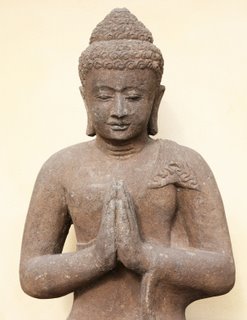 a mediation practice can be done anywhere and anytime Everybody needs a sanctuary, a place to rest and renew. The beauty of meditation — a proven and profound form of self-care for mind and body — is that almost anytime, anywhere, you can access that place of restorative calm.
Yet for some, meditation sounds mysterious or intimidating, probably because of some common misconceptions: that it’s dry or boring or “too spiritual”; that it’s an esoteric practice for those operating on some higher, more rarefied plane.
Yes, meditation is an ancient spiritual practice — one that cuts across different religions and many different traditions. But what it boils down to — however it’s practiced and whatever form it takes — is this: To meditate simply means to rest in moments of appreciative, exquisite attentiveness. Moments that allow us to savor the experience of living and that make us feel both deeply calm and deeply alert, in tune both with our self and with the world around us. Moments we come away from feeling refreshed, renewed, and engaged. Meditation is a way of communing with spirit.
 meditate under tree We all know how to meditate; it’s an instinctive ability. If you’ve ever been deliciously absorbed gazing at the flow of a river, the dance of a fire, or the twinkle of stars, you’ve enjoyed meditative moments. And you can create those moments almost anywhere at any time. If you have a favorite place in your home in which to meditate, that’s wonderful. But you can meditate just as effectively sitting at your desk or on a park bench, or lying in the grass. The fact is, the juicier and more sensual you let meditation be, the more you will get out of it.
Meditating on a daily basis is easy. Give yourself a space of time — 10 to 20 minutes morning and afternoon, or if that’s not possible, a few minutes here and there throughout the day. Set your Bamboo Zen Meditation Timer for a at least 5 minutes. Choose a pleasing, peaceful focus for attention — sensations, such as the flow of your breath; a sound you make, such as ahhh; or a visual image, such as waves coming to shore. This is your home base. Lightly focus your attention, and when your mind wanders off, gently come back to home base. Minds wander — a lot. So go easy on yourself and accept the process.
Although meditation can be done in almost any context, practitioners usually employ a quiet, tranquil space, a meditation cushion or bench, and some kind of timing device to time the meditation session. Ideally, the more these accoutrements can be integrated the better. Thus, it is conducive to a satisfying meditation practice to have a timer or clock that is tranquil and beautiful. Using a kitchen timer or beeper watch is less than ideal. And it was with these considerations in mind that we designed our digital Zen Alarm Clock and practice timer. This unique “Zen Clock” features a long-resonating acoustic chime that brings the meditation session to a gradual close, preserving the environment of stillness while also acting as an effective time signal.
adapted from Body + Soul Magazine, June 2005 by Lorin Roche and Camille Maurine
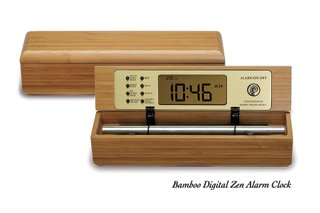 Bamboo yoga and meditation timer, designed especially for meditation practitioners Now & Zen’s Chime Timer and Alarm Clock Store
1638 Pearl Street
Boulder, CO 80302
(800) 779-6383
Posted in intention, Meditation Timers, Meditation Tools, mindfulness practice, Now & Zen Alarm Clocks, Well-being, Zen Timers
 Benefits of Sleep Wake up! New research reported by the American Association for the Advancement of Science shows that sleep is one of the brain’s most powerful tools for learning and remembering. University of Chicago researcher Daniel Margoliash found evidence that young birds practice singing while they sleep: Brain cells active during waking hours showed similar firing when the baby birds napped. “Birds dream of singing,” Margoliash says. And after navigating a spiral maze all day, rats apparently dream of running. Matthew Wilson of the Massachusetts Institute of Technology reported that the sleeping rodents’ brains replayed electrical signals characteristic of running. In human laboratory experiments, students who were tested and then allowed to sleep before retesting showed consistent improvement.
In fact, Robert Stickgold of the Massachusetts Institute of Technology reported that a period of sleep between tests resulted in a 20% boost in performance without additional training, and “the more sleep the students got, the more they improved.” Says Stickgold, “Modern life’s erosion of sleep time could be seriously short-changing our education potential.” He says that “cramming all night may help you pass a test, but if you want to remember any of it after college, you need to sleep on it.”
adapted from Natural Solutions, Aug, 2002
Boulder, Colorado—an innovative company has taken one of life’s most unpleasant experiences (being startled awake by your alarm clock early Monday morning), and transformed it into something to actually look forward to. “The Zen Alarm Clock,” uses soothing acoustic chimes that awaken users gently and gradually, making waking up a real pleasure. Rather than an artificial recorded sound played through a speaker, the Zen Clock features an alloy chime bar similar to a wind chime.
What makes this gentle awakening experience so exquisite is the sound of the natural acoustic chime, which has been tuned to produce the same tones as the tuning forks used by musical therapists. According to the product’s inventor, Steve McIntosh, “once you experience this way of being gradually awakened with beautiful acoustic tones, no other alarm clock will ever do.”
 Chime Wake Up Clock by Now & Zen Now & Zen’s Chime
Alarm Clock Store
1638 Pearl Street
Boulder, CO 80302
(800) 779-6383
Posted in Bamboo Chime Clocks, intention, Natural Awakening, Now & Zen Alarm Clocks, Sleep Habits, Well-being
 Morning You don’t have to be a naturally early riser to enjoy all that the morning has to offer. With the right perspective and a few small adjustments, you can turn your morning into one of the most relaxing and energizing parts of your day.
“The morning has incredible potential,” says Alison Novie, senior yoga instructor at Kula Yoga in Manhattan. “I think of the new day as a new year — a whole new life. If you could modify just a few things about your morning, it would change the way you see your day.”
To some degree, you don’t have much choice about how you feel when the sun comes up. Not everyone is born a morning person. But that doesn’t mean your mornings can’t change for the better. It’s worth tinkering with your natural inclinations to reap the rich rewards.
Quiet, full of expectation, yet uncluttered by conversation and untouched by the demands of the day, the morning presents an opportunity for you to find joy, peace, and strength — or at the very least, the chance to ease into the flow so that you aren’t thrown into your day headlong and half awake. We’ve spoken with a renowned sleep expert, a yoga instructor, and a Reiki healer for their insights on everything from getting a good night’s sleep to practicing mind/body awareness to incorporating a sense of play early in the day. Their strategies work well together or individually. Find the ones that work for you, and enjoy them in and around your current morning chaos, whether you live alone, with two dogs, or with five kids. By taking the time to stimulate your senses and relax your body and mind, you’ll start out calmer, more energized, and better prepared for whatever lies ahead.
Reset Your Natural Alarm
First things first: You’ll never enjoy the morning if you don’t get a good night’s sleep. For some people, that means a solid nine hours of uninterrupted slumber; for others, seven hours of shut-eye will do. Sleep expert James B. Maas, Ph.D., author of Power Sleep, notes that eight hours of sleep is the average — but only an average, not a rigid goal. When you’re not getting enough sleep, you’re the first to know. Shifting your sleep schedule is possible, says Maas, but it requires commitment. “If you’re a night person, and you want or need to become a day person, you can do it, but you have to be serious about it. You can’t flip-flop,” he advises. Here’s how to alter your habits in favor of an earlier (and happier) morning.
Make a gradual shift. If you find it hard to fall asleep at night, take things slowly when it comes to establishing a new time for bed. Try hitting the hay five minutes earlier each night, and in less than two weeks you will have shifted your bedtime by one hour.
Resist the urge to snooze. Hitting the snooze bar is an exercise in futility — and torture. You’ll get at best 5 or 10 minutes of fragmented sleep, notes Maas, and may arise feeling groggier than when your alarm first went off. Instead of sneaking in 10 more minutes of sleep, try going to bed 10 minutes earlier instead.
Expose yourself to bright daylight. This is one of the best and most effective things you can do to wake yourself up, says Maas. By opening the curtains and the windows or getting outside, you cue your brain to repress the production of melatonin, the hormone that regulates sleep. Natural daylight works best, but if you get up before sunrise or simply can’t get enough natural light, consider using a sun-mimicking device as an alternative.
Don’t lose sleep over exercise. While you may choose to exercise in the morning, Maas recommends against sacrificing sleep for it. “Never truncate your sleep in order to work out. This puts you at a greater risk of injury,” he advises. Only when you have had enough uninterrupted hours of sleep should you think about getting up to exercise.
 Chime Alarm Clocks and Meditation Timers - Mother and daughter Harunobu Be consistent. “You don’t get two biological clocks — one for weekdays and one for weekends,” says Maas. “That means you have to stick by one.” Sleeping late on the weekends to compensate for lack of sleep during the week will throw you off, making Monday mornings even worse than they need to be. While keeping a consistent sleep schedule is ideal, it’s not always reasonable or practical. Your best bet is to try to keep your schedule fairly regular (that is, getting up and going to bed within an hour or so of your weekday schedule).
Plan your evenings. How you wind down the day may affect the quality of your sleep — and therefore the quality of the following morning. For some, eating a chocolate bar, watching a dramatic movie, or arguing right before bed will be enough to derail sleep. Be aware of your particular sensitivities; avoid those things you know will keep you up.
Boulder, Colorado—an innovative company has taken one of life’s most unpleasant experiences (being startled awake by your alarm clock early Monday morning), and transformed it into something to actually look forward to. “The Zen Alarm Clock,” uses soothing acoustic chimes that awaken users gently and gradually, making waking up a real pleasure. Rather than an artificial recorded sound played through a speaker, the Zen Clock features an alloy chime bar similar to a wind chime. When the clock’s alarm is triggered, its chime produces a long-resonating, beautiful acoustic tone reminiscent of a temple gong. Then, as the ring tone gradually fades away, the clock remains silent until it automatically strikes again three minutes later. The frequency of the chime strikes gradually increase over ten-minutes, eventually striking every five seconds, so they are guaranteed to wake up even the heaviest sleeper. This gentle, ten-minute “progressive awakening” leaves users feeling less groggy, and even helps with dream recall.
adapted from Body +Soul Magazine, March 2006
Now & Zen’s Chime Alarm Clock Store
1638 Pearl Street
Boulder, CO 80302
(800) 779-6383
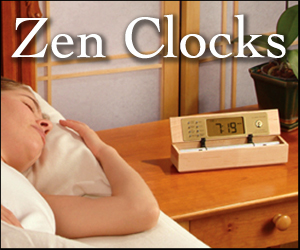 Chime Alarm Clocks - The Digital Zen Alarm Clock
Posted in Chime Alarm Clocks, Natural Awakening, sleep, Sleep Habits, wake up alarm clock, Well-being
 Decluttering a bedroom space, Digital Zen Alarm Clock What’s the first space in your home that experts recommend tackling when you declutter? If you said the living room, kitchen or foyer, guess again. It’s the bedroom.
“I always start with the bedroom,” says feng shui consultant Andrea Gerasimo of Menomonie, Wisconsin. “It’s your sanctuary.” Gerasimo cites studies showing that what you’re thinking when you nod off affects how you sleep and your mood when you wake up. So if your last mental image is of chaos and clutter, you’re not setting the right stage for quality sleep.
In your bedroom space, do you trip over piles of clothing, boxes, shoes and assorted tchotchkes? Are stacks of DVDs careening from your bedroom entertainment center? Or, perhaps you’ve placed your home office—with its tangle of computer and phone lines, file folders, sticky notes and miscellaneous office supplies—in your sleep space.
The good news is that you don’t have to remodel to streamline your bedroom.
Rearranging furniture (even better, removing a few items), decluttering and adopting a resolute mindset to keep your bedroom space harmonious and clutter-free are simple steps that can make a big difference.
Transform your bedroom from cluttered chaos to serene retreat with these easy tips.
1.Furniture: Less is More
Having too many dressers, tables and chairs jammed into a space—no matter how large—makes it feel smaller. And stuff attracts more stuff. As we add more pieces, we tend to fill them, inside and out.
Solutions:
■ Invite a friend with a fresh set of eyes over for a streamlining session. Move everything out, then open your mind to new arrangements. Bring in the pieces you love most until the room seems adequately furnished but not overly stuffed; the remaining furniture is probably unnecessary. Choose a Zen Alarm Clock for the space next to you bed on your table. Pick the Digital Zen Alarm Clock that has a lid that can be closed to further declutter your bedroom space.
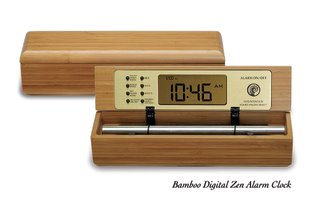 Bamboo Digital Chime Clock, closing the lid to the clock helps declutter your bedroom space ■ Think about what you can donate, use elsewhere or sell. Candidates for the chopping block may include exercise equipment, a dresser, even your television. Family manager coach Beth Dargis of Holland, Michigan, singles out dressers as occupying too much space in a room. (What’s more, their long, low surfaces invite clutter, she says.) Whenever possible, Dargis recommends replacing a dresser with a highboy, which holds roughly the same number of items but with a smaller footprint.
■ While everything is out of the room, consider spiffing up your walls with a fresh coat of no- or low-VOC paint (VOCs are volatile organic compounds that outgas into the air). If you want to change your window treatments to hemp or organic cotton, this is an ideal time. At the very least, give your bedroom a good, thorough cleaning before moving furniture back in.
2.Clothing: The Hidden Culprit
Anytime you declutter a bedroom, you invariably run into a surfeit of clothing, shoes and accessories. This accumulation is the root cause of a number of ills. “People cram in another piece of furniture instead of going through their wardrobes and getting rid of what no longer fits,” says New York interior designer John Loecke, author of the Organizing Idea Book (Taunton, 2006). Many times, Loecke has seen couples introduce substantial armoires to their bedroom space to accommodate one person’s wardrobe because the other’s has overtaken the closet.
 zen-like bedroom Solutions:
■ First, simply pare down. Set aside half a day (with a decluttering buddy, if you can find one) and go through your wardrobe ruthlessly, donating what no longer fits, what you haven’t worn in a year or two, and what’s outdated. Take everything out of the closet and put it in piles to donate or consign, trying on only the items you aren’t sure about. (In the process, I guarantee you’ll discover at least one “treasure” that you’ll want to reclaim!)
■ Once you’ve whittled down your wardrobe, adopt a practice I’ve been following for years. Put two containers in your closet: one for donation, one for consignment. As soon as I wear an item and decide it’s no longer for me, I place it directly into one of the boxes. As soon as one fills, I pop it in my car and drop it off at my charity or resale shop.
■ Once you’ve reduced your holdings, you’ll be surprised at the amount of space you’ve freed up. Before you begin to reload, take this moment to sort everything by category—separate all shirts, dresses, pantsuits and tops into categories. Organize shirts and blouses according to color, from light to dark, or by use, such as dress shirts and T-shirts. This system helps you see what you have. (If you still have more than your closet will bear, and if you have a climate-controlled attic or basement space, you can rotate out-of-season items.)
■ To further streamline, remove as much as possible from the closet floor. A hanging shoe rack helps get shoes up and in sight. The same goes for ties, belts, scarves and hats. As you organize your wardrobe, it’ll be easier—and obvious—to see what you have and which items to chuck.
3. Streamline Bedding
Sometimes the bed itself—including all the attendant bedding and pillows—can create visual clutter.
 how to declutter your bedroom space
Solutions:
■ Bed size—like just about everything else in America these days—has become supersized. But do you really need a king-size bed? When you’re shopping for your next bed, consider scaling back and opting for a smaller model—if not a full, then try a queen.
■ Also consider streamlining your bedding, says Lisa Quinn, San Francisco-based
interior designer and author of $500 Room Makeovers (Clarkson Potter, 2006). Instead of feathering your nest with brightly colored, matched bedding sets, why not go for basic whites or plain pieces in a limited color palette? If you spill red wine on your butterflies-in-flight pillowcases—or if your zebra-print bottom sheet fades more quickly than the flat—you’ll probably have to discard the entire set to achieve harmony. Plain pieces are interchangeable; you can simply make up any loss with a generic replacement. You also can pick up spare linens at thrift shops and consignment stores. “If your bedding is all white,” Quinn says, “it can take so much off your plate!”
■ Instead of piling on the pillows, pare down to only those you actually use. It makes for a Zen-like bed, and you don’t have to juggle all the extra “show” pillows when you get into bed at night.
4. No Place for Your (Home) Office
Your bedroom should be a pleasure palace or at least a haven for sleep and retreat—not a place where you pay bills, haggle and hassle.
Solutions:
■ If you’ve placed your home office in your bedroom space, try to issue an eviction notice. Any place in the house—including the kitchen, dining room or guest room—is better than your bedroom. A friend in Los Angeles converted a garden shed into a home office, giving her physical separation from her house and a discreet space to do her work as a freelance writer. Another enterprising Los Angeles friend (also a writer) bartered five hours a month of her writing and public relations services in exchange for free space in a lawyers’ office. They even threw in use of their copier.
■ If you see no other solution than putting your office in the bedroom, choose a place where you can shut the doors, such as a closet or computer armoire. Being able to physically close off your home office will help promote peace of mind and better sleep, which, in turn, will make you more productive when you work.
Daily Rituals
These rituals will improve your bedroom’s serenity quotient.
1. Make your bed every day—preferably when you get up in the morning and before you do anything else.
2. Open your draperies or blinds to let the sun shine in.
3. When you come home at the end of the day, hang your clothes or place them in the laundry basket. Avoid the temptation to drape them on a chair.
4. To avoid bedside clutter, keep just one of everything out: the book you’re reading; one bottle of lotion; one pair of slippers.
5. Finally, scrutinize every new item that you introduce into your bedroom. You can avoid the problem of accumulated clutter by making conscious choices in the first place.
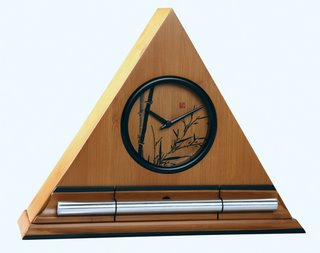 Bamboo Zen Clocks, progressive chime clock and timer adapted from Natural Home Magazine, November/December 2009 by Wanda Urbanska
Now & Zen – The Zen Alarm Clock Store
1638 Pearl Street
Boulder, CO 80302
(800) 779-6383
Posted in Bamboo Chime Clocks, Chime Alarm Clocks, Japanese Inspired Zen Clocks, Natural Awakening, Now & Zen Alarm Clocks, Sleep Habits, Well-being
« Previous Page — « Previous Entries
Next Entries » — Next Page »
|
|
|
|